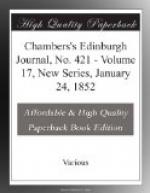We may allude here to a very singular physical property which is possessed by the elephant’s tusk. Specimens have frequently been obtained which were found to contain musket-bullets in their centre, surrounded with a species of osseous pulp differing from the ordinary character and constitution of ivory. There was frequently no corresponding orifice on the surface of the tusk; and hence Blumenbach, and other naturalists, were led to form some very inaccurate notions regarding this circumstance. Mr Rodgers of Sheffield some years ago forwarded a variety of such specimens to the Edinburgh College Museum, and these were very closely examined by Professor Goodsir, who, in a communication to the Royal Society of Edinburgh, demonstrated that this arose simply from a property of isolating foreign substances common to all osseous organised bodies: the ball having been enclosed by the tusk in its pulpy secretion, and corrosive action thereby prevented, the process of growth continued without interruption.
Ivory is a solid, white, translucent substance, distinguishable from bone by its beautiful texture of semi-transparent rhomboidal network. The finest ivory is much more transparent than paper of the same thickness. A thin transverse section placed under the microscope exhibits a series of curvilinear lines diverging from the centre and interlacing each other with great regularity and beauty, closely resembling in appearance the engine-turning of a watch. It possesses a specific gravity varying from 1.888 in the tooth of the walrus, to 2.843 in that of the elephant. Its mean gravity is therefore about two and a half times greater than water. The best, finest, and most valuable ivory is that obtained from the African elephant. When recently cut, it exhibits something of a yellowish transparent tint, which is due to the oil it contains, but this gradually changes to a beautiful and permanent white. It is not easily stained or destroyed by exposure to the atmosphere, and on that account is used in the arts for all the higher purposes, and especially for carved ornaments—such as chess-pieces, crucifixes, and articles of virtu. Indian ivory, on the contrary, when first cut, is perfectly white, but it becomes yellow and discoloured with age and exposure. A good illustration of this circumstance is presented by the dingy-coloured keys of an old pianoforte.
This popular definition of good and inferior ivory is however, in point of fact, somewhat incorrect, since ivory obtained from the coast of Africa is often much inferior to that obtained from the Indian Archipelago. The best rule for determining the quality is probably that of its vicinity to the equator. The ivory brought from within the 10th degrees of north and south latitude is incomparably the finest in the market; it is at the same time the most transparent, which of itself is a valuable characteristic. Our Indian ivory for some years back, instead of being shipped




